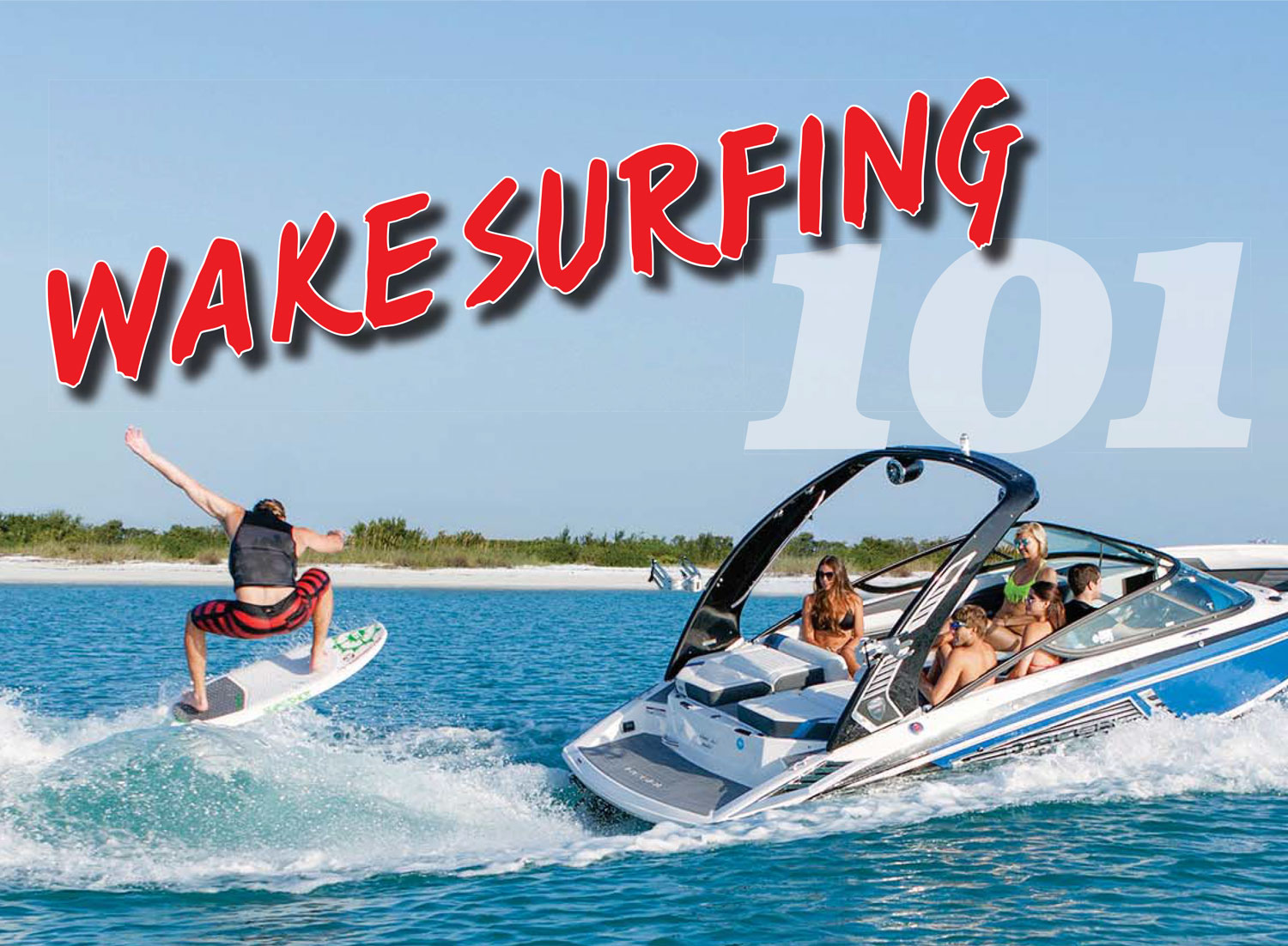A BEGINNERS GUIDE TO THE HOTTEST WATER SPORTS OF THIS SUMMER
By Zenon Bilas
Wake surfing is generating tremendous excitement today. “Surfing” on a boat wake takes inspiration from surfing, skateboarding, wakeboarding and trick skiing, but has its own distinct personality.
Innovation in equipment is fueling the growth. Boat builders are designing models with hulls and other features that create the optimal wake, and manufacturers have been motivated to shape boards specifically for the sport. Once you have the boat, all you need is a board and a specialized 20 foot line. (A board and line starter package can be $300 to $400.)
Secondly, wake surfing provides a fun workout with minimal impact on the body. At about 10 mph, falls are usually gentle. And with no bindings to hold your feet to the board, ankles and knees stay safer during falls. This makes wake surfing very appealing to a wide audience of all ages.
Wake surfing is social. Adding more people to the boat actually increases the wake size, so invite as many friends as the boat can safely accommodate. Since the wake surfer is closer to the boat than in water skiing or wakeboarding, your passengers are up close to the action and can easily shoot photos and videos.
History of Inland Surfing
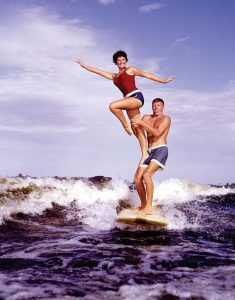 Surfing behind a boat was done as early as 1956 at Cypress Gardens, according to Simon Khoury, a member of the Cypress Gardens water ski show team in the 1950s. The skiers called the sport “inland surfing”. Their photo boat Miss Cover Girl, 50’ long by 10’ wide powered by twin inboard V8 engines, was the perfect wake surf boat.
Surfing behind a boat was done as early as 1956 at Cypress Gardens, according to Simon Khoury, a member of the Cypress Gardens water ski show team in the 1950s. The skiers called the sport “inland surfing”. Their photo boat Miss Cover Girl, 50’ long by 10’ wide powered by twin inboard V8 engines, was the perfect wake surf boat.
Dick Pope Sr., founder of Cypress Gardens, saw the potential of using Inland Surfing to promote Cypress Gardens. He hired pro surfers including Hobie Alter (of Hobie Cat fame) from California to teach the Cypress Gardens skiers to surf behind Miss Cover Girl. By the late 60s, surfing at Cypress Gardens faded from popularity and Inland surfing remained relatively dormant for 25 years.
In the mid 90s, Rick Lee of Centurion Boats saw the crossover potential of the bigger wakes of the v drive ski boats that were being designed for wakeboarding. The push by Lee to make boats for wake surfing in the mid 90s, along with his drive to turn wake surfing into a competitive event with a World Championship, motivated manufacturers to make boards specific for surfing the wake. Inland surfing was reinvented as wake surfing.
The Wake Surf Boat
The size and shape of the wake is the most important element in wake surfing. The right wake makes learning easier for novices and allows experienced wake surfers be more creative. And wake surfing allows you to build and control the quality of the wake whatever the weather.
The boat’s length, beam and weight all affect the wake size and shape. Boats with the engine placed aft as in v drive wakeboard boats have larger wakes. The size and shape of the wake is also determined by the boat’s hull design. A boat with more deadrise (or more v shape in the hull) at the transom will cast a bigger wake. Manufacturers continue to come up with innovations in hull design. Even stern drive manufacturer Volvo Penta introduced a stern drive with a forward-facing propeller, which keeps the prop away from the swim platform.
Accessories allow you to further refine the wake, including tank and bladder style ballast in various sizes and shapes. You can add more weight to the side of the wake you will be wake surfing on to make the wake bigger.
So now, you’ve got your boat, board and line. The next step is to get your wake shaped just right. You want about a 10 to 15 foot section of tall sloping wake that is clean and crisp at the top. That’s the area where you will be surfing. An experienced surfer can try it first and make suggestions.

Wake Surf Boards
 The long surfboard has evolved into a smaller, shaped board specifically for wake surfing, with three general categories: Beginner, Surf and Skim styles.
The long surfboard has evolved into a smaller, shaped board specifically for wake surfing, with three general categories: Beginner, Surf and Skim styles.
Beginner boards offer performance for learning your first tricks but provide more board space to make riding easier and accommodate a wider range of body types. The bigger board also makes surfing a smaller wake easier. Consider a small board for young surfers. It will be less buoyant, making it easier for kids to get up and control the board.
Surf style boards feature plenty of rocker (curvature from tip to tail) like surf boards and feature up to 6 fin locations to vary the surfing characteristics of the board, however, for best tracking without adding too much drag, use no more than 4 fins at one time.
Skim boards feature less rocker and a thinner profile, giving the board more speed. These boards typically feature fewer fins, so the board holds less to the water. This allows a more free ride, letting you do skateboard inspired tricks at the top of the wake.
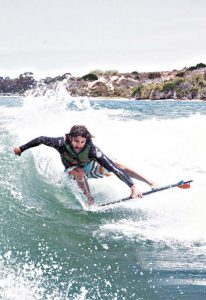 Hybrid models featuring a cross between surf and skim designs are making a debut, as are boards that feature a fin at the nose of the board for riding switch.
Hybrid models featuring a cross between surf and skim designs are making a debut, as are boards that feature a fin at the nose of the board for riding switch.
Get Started
You need to decide whether you will ride right or left foot forward. If you surf, skateboard, water ski or wakeboard, you will already have a preference. With the wake surf line stretched out, hold the handle like you do for getting up on skis or wakeboard. The board should be sideways in front of you with just your heels placed near the edge of the board. Your forward foot should be at about the center of the board. With the board’s buoyancy, you will not be able to place the bottoms of your feet on the board at this point. This might feel awkward but once the driver puts the boat in gear, the bottoms of your feet will go securely on the board.
Have the driver put the boat in gear and slowly accelerate. You only need about 10 mph and you have a lot of surface area, so the driver does not need to accelerate aggressively. At this point, it’s like getting up on skis or a wakeboard, just use your leg strength to raise your seat into an upright body position.
As you are rising, use your legs and feet to turn the tip of the board toward the boat. As you are completing the start, go outside the wake to the side you intend to surf. It’s best to surf on the side where your toes and chest face the wake.
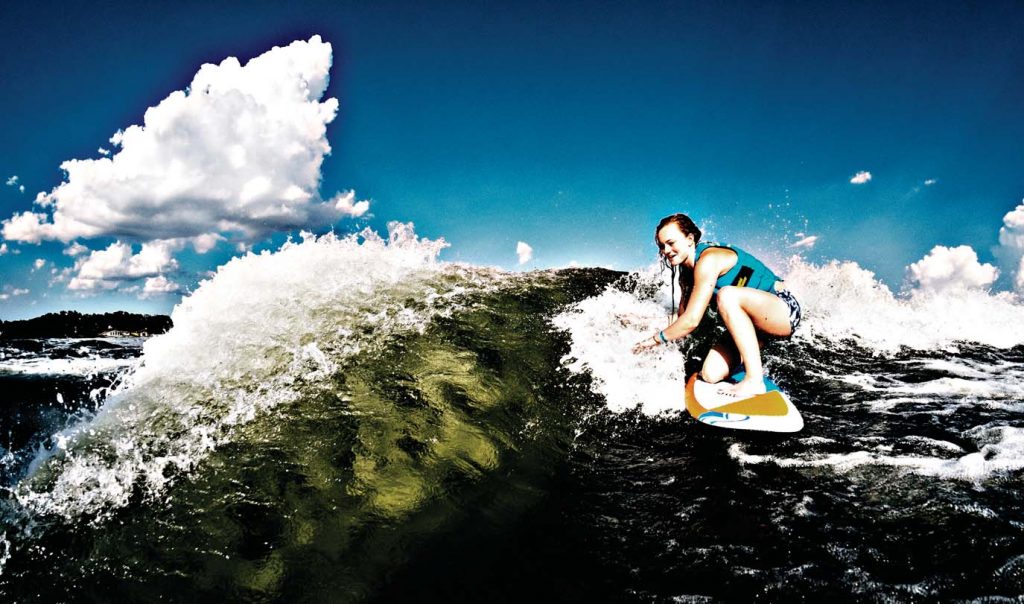
Balance and Technique
Work on your balance in sideways stance while still holding the handle. Spread your weight over your feet with a bit more on the back foot. Move away from the wake and return. Then begin making surf carves. Start slow and increase your intensity, going higher up the wake.
You need plenty of flex in the ankles and knees. Use leg strength to apply pressure to your feet to make the board do what you want it to do. With the line in hand, adjust speed or line length to find the sweet spot on the wake where you have the speed needed to move you along. This is just past the initial prop wash and just before the wake becomes a whitewash where for about 10 to 15 feet the wake slopes to a tall crisp clean point.
Speed up the board by putting more weight on your front foot or slow down the board by putting more weight on the back foot. When the board goes faster, you will get closer to the boat and when you slow the board, you will fall away from the boat. When you are balanced just right the line will feel light and have some slack to it. Once you can sustain that spot, toss the handle toward the wake so that a designated person in the boat can pull in the line.
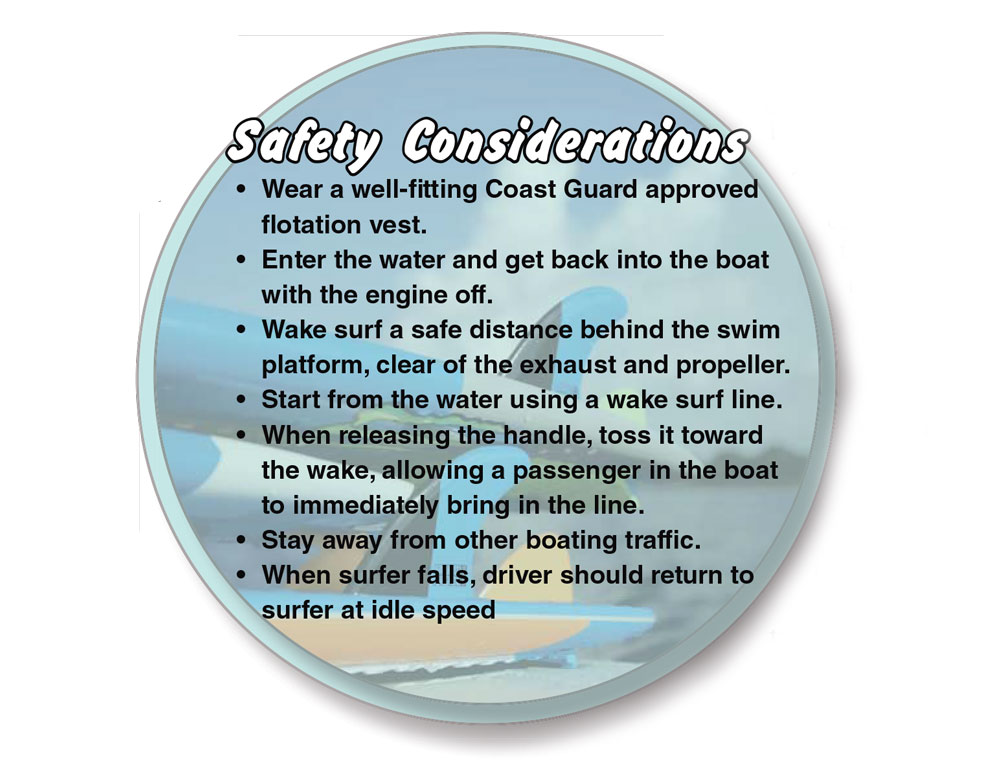 Getting Better
Getting Better
Use your ability to speed up or slow down the board to do tricks. Use the power in your legs to make more impressive surf-style carves up the wake. Let the nose of the board get air and then make snap turns or let the board go from the wake to get air. As you learn the basics, you can then add tricks like a 360. Soon you will create your own signature style.
So surf’s up! Have fun with your family and friends, inland surfing 21st-century style!

